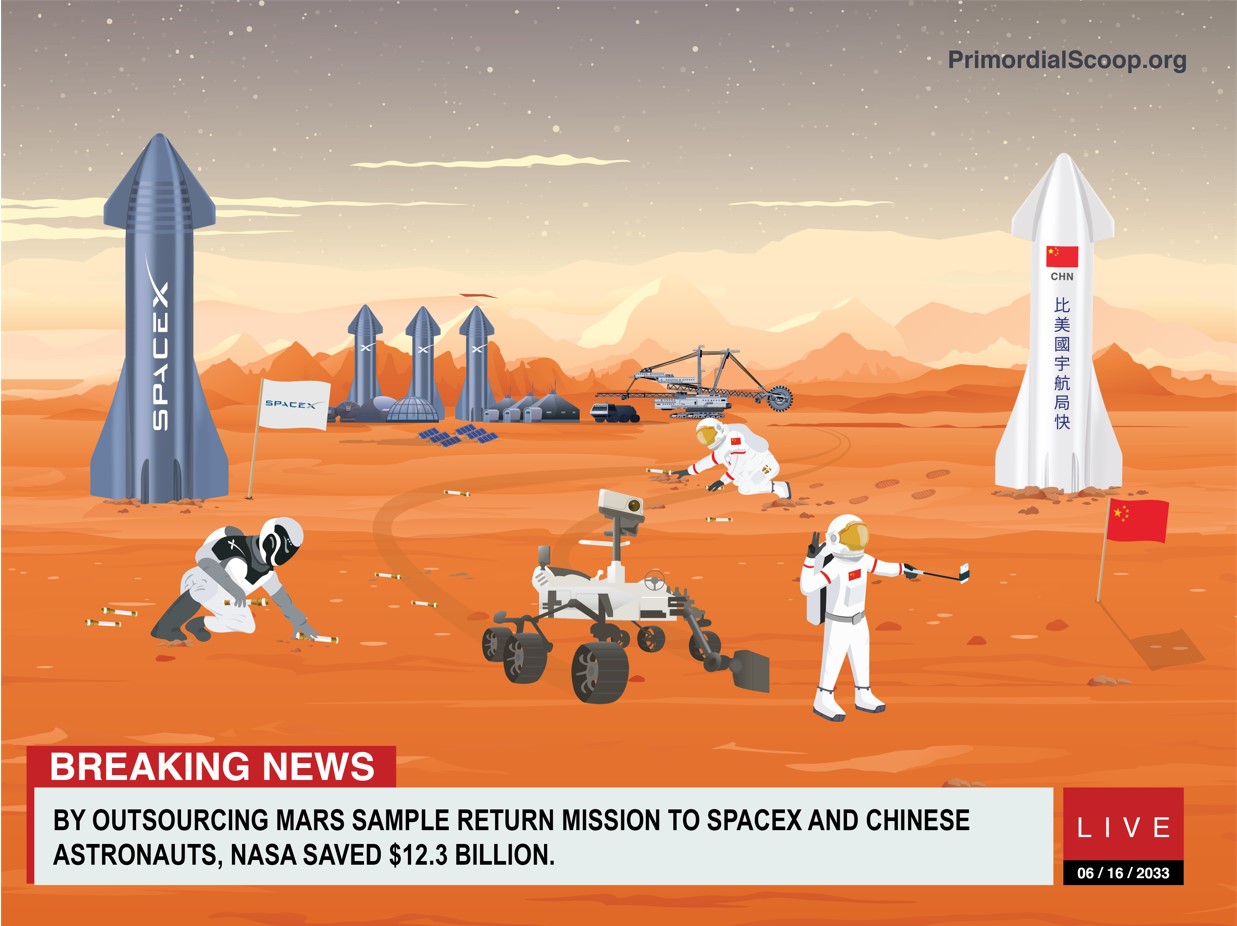Cite as: Spacek, J. (2022) “2022 State of NASA Address: Astrobiology at NASA no longer looks for life on Mars”. Primordial Scoop, e20220401. https://doi.org/10.52400/GTIL9806
A short report summarizing the State of NASA Astrobiology 2022 just reminded us that NASA no longer looks for life on Mars. This report stated that Viking missions in the 1970s “did not detect evidence of life” and that all the current and planned missions are all focused only on the search for the past life and past habitability. That includes the top priority astrobiological mission, Mars Sample Return, recently delayed to 2033.
This summary did not include any other explanation why is NASA not looking for the current inhabitants of Mars. Hence the only interpretation could be that NASA has given up searching for life on Mars because (of a misinterpretation) of the Viking missions results.
This actually is not a change in past policy. For a half century now, NASA has acted as if Viking showed the absence of life on Mars.
We, of course, cannot use data from Viking to show that Mars is lifeless. Even if the results from Viking were indisputably negative (which they weren’t), at best we could have concluded that there is less than detectible amount of life in the samples Viking collected.
Further, the assumption of sterility of Mars is at odds with the 2019 Astrobiological Carlsbad conference report, which concluded that life is likely present on Mars.
And finally, we showed here that the Viking biological experiments results interpretation as negative was simply wrong.
If you know the science behind the Viking missions, and current advances in astrobiology, you have no good reason to not to look for life on Mars. On the other hand, you have really good reasons to look for life on Mars right now, while it is still in its pristine, not-yet-contaminated, form.
To put the NASA Astrobiology current plans for Mars into perspective, by the year 2033 conclusion of the Perseverance program, SpaceX will have built a permanent colony on Mars, even if we account for Elon’s optimistic deadlines and FAA’s efforts to delay SpaceX progress.
Although China has not set an official date for Mars crewed landing, the year 2033 was mentioned in documents from Aerospace China. I suspect that for political reasons, China will want to beat NASA to the Mars and will be willing to risk their astronaut’s lives to do so.
Finally, NASA Administrator Bill Nelson just now announced a plan “for humans to walk on Mars by 2040”.
Humans on Mars will be a great leap forward. Humans on Mars will be an inspirational moment for the next generation of scientists and engineers, and moving humans off of the Earth will change our civilization forever. But humans on Mars may also cause severe problems from astrobiological perspective.
The first problem is related to NASA’s PR.
By the 2030s NASA Astrobiology will be a butt of many jokes.
NASA is now funding robotic return sample mission to Mars, which has the goal of bringing back handful of Mars regolith for billions of dollars. On its own, this mission is very important; on Earth we will have better tools how to study this Martian material, potentially even finding signs of the alien life. What makes the mission ridiculous is its timing. As noted above, this mission will likely occur at the time when SpaceX and Chinese Astronauts will be bringing large amounts of handpicked Martian samples, making NASA’s efforts redundant, and irrelevant from a planetary protection perspective.
On the other hand, by the 2030s, NASA should be familiar with ridicule if it sticks to its archaic and expensive Space Launch System. Comparison of SLS with modern, fully reusable, and efficient private rockets throughout the 2020s should prepare NASA administrators for more trolling about NASA’s inefficiency in astrobiological missions in the 2030s.
Jokes aside, the second problem is that we might cause an unintentional interplanetary genocide.
As noted in the official COSPAR and NASA planetary protection documents, human presence on Mars will inevitably lead to forward biological contamination. Because humans cannot be sterilized to the standards required for the robotic missions, crewed Mars missions will certainly and irreversibly contaminate Martian surface with Earth’s biological material. (Which makes current Martian robot sterilization rather pointless exercises.)
In my opinion, it is unlikely that this Earth’s life will cause extinction of Martians. After all, Martians are evolved to survive in Martian conditions. Hence the extermination will be at least slow, if not impossible.
But we, the biologists, should keep in mind, that we were frequently wrong about the threats of invasive species in the past. Several factors are relevant:
Because of its slower metabolism determined by average Mars temperature, Martian life will likely be evolutionary much younger than Earth’s life. The biological age of Martians, when counted in number of generations, might be comparable to the biological age of Earth life 3 billion years ago. These primitive Martians might be outcompeted and eaten by the more advanced Earth bacteria, before we have a chance to study them.
COSPAR and NASA planetary protection documents also mention the threat of backward contamination, where the Martians would come back with humans to be introduced into Earth’s ecosystem. This again seems unlikely, but we cannot dismiss a scenario where Martian life colonizes Earth permafrost regions and tamper with the Earth’s global ecosystem in the next millennia.
A third scenario, where biological contamination will prevent or at least severely hinder the search for the indigenous Martians, is much less sinister, but also much more likely.
Despite these unlikely black swan events (interplanetary invasive species) and despite of certainty that Earth’s biosignatures on Mars will irreversibly hinder or prevent future astrobiological exploration, NASA’s Network for Life Detection (NfoLD) is not even discussing these issues.
Instead, they focus on other water worlds, that would in my opinion, benefit from a mission delay. While all life detection science will improve over time due to advances in technology, only the Mars life search mission has a clear deadline determined by the first crewed landing. Other potentially habitable moons and planets are (at least for conceivable future) safe from human-carried biological contamination.
My guess is that NASA decided to ignore the deadline on the search for life on Mars because they do not see a viable solution to this problem. Therefore, it seems to me that NASA chose to use an “ostrich policy,” and “solved” the problem by pretending it simply does not exist.
Regardless of the real reason why NASA has decided not to look for life on Mars, the deadline on the life detection exist and someone else should step in to do what NASA ignores.
I’m a member of a team that plans 2023 private mission to study Venus clouds. This mission could be an inspiration for philanthropists. With MIT and Rocket Lab, we are trying to uncover (among other things) the century long mystery of the UV-visible absorber in the cloud of Venus. Based on the experiments that we’ve done at Firebird and based on the ongoing mission design, I believe we will succeed. I believe that the data gathered during the next year mission will show us what causes Venus to be, as Carl Sagan put it, “pale lemon yellow.” The century long mystery of the Venus absorber will likely be solved by a private interplanetary mission and a private research company.
Similarly, our Agnostic Life Finder (ALF), is a simple add-on to the human Mars mission design. Before first humans land on Mars (and irreversibly contaminate it), a large-scale resource utilization mission must be done to prepare propellant for an ascent vehicle, and to accumulate resources for the future Mars explorers. This remote ISRU is the last chance to find life on Mars and ALF is here to use this last opportunity to study the pristine Mars. Wealthy individuals have now a limited window of opportunity to do what NASA decided not to do. Let’s find life on Mars.
Author’s note: At the time of writing I was not aware of the frequent exchange of the material between Earth and Mars. Impact ejecta is constantly exchanged in both directions. Mars is not biologically isolated from Earth and vice versa. Planetary protection documents seems to disregard this this fact.



In 2022 Bill Nelson STILL says that Viking “did not detect evidence of life”, a quarter century AFTER organic chemists debunked the logic behind that conclusion.
And since Administrator/Senator Nelson is being advised by his staff, it seems that his staff ALSO does not “do” organic chemistry. Nor do their peer review panels. Or perhaps they just do not do logic.
“Help us, Obi-wan Musk/Obi-wan Bezos. With NASA now being irrelevant to the search for extra-terran life in places where it is most likely to be found, you are our only hope.”